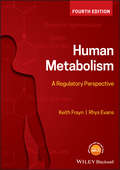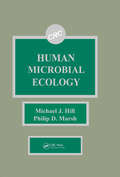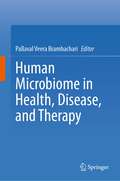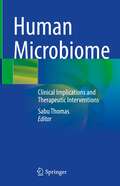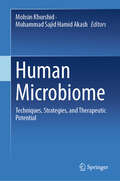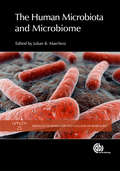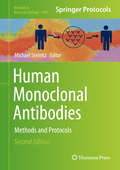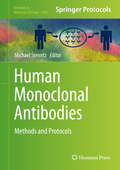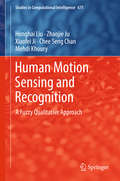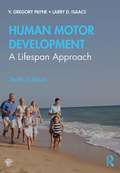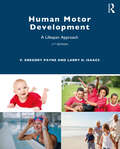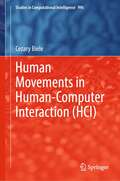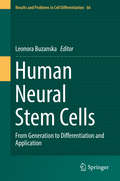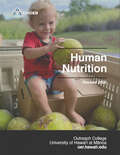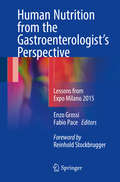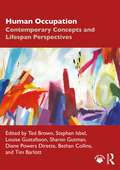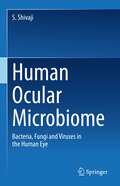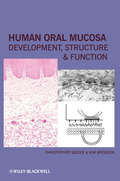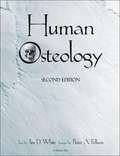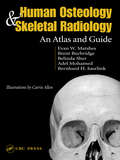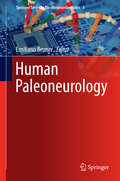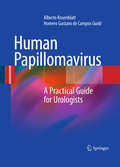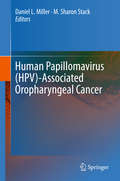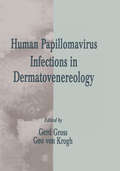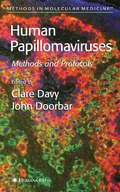- Table View
- List View
Human Metabolism: A Regulatory Perspective (Frontiers In Metabolism/neurobiology Ser. #No. 1)
by Keith N. Frayn Rhys EvansThe updated bestselling guide to human metabolism and metabolic regulation The revised and comprehensively updated new edition of Human Metabolism (formerly Metabolic Regulation – A Human Perspective) offers a current and integrated review of metabolism and metabolic regulation. The authors explain difficult concepts in clear and concise terms in order to provide an accessible and essential guide to the topic. This comprehensive text covers a wide range of topics such as energy balance, body weight regulation, exercise, and how the body copes with extreme situations, and illustrates how metabolic regulation allows the human body to adapt to many different conditions. This fourth edition has been revised with a new full colour text design and helpful illustrations that illuminate the regulatory mechanisms by which all cells control the metabolic processes necessary for life. The text includes chapter summaries and additional explanatory text that help to clarify the information presented. In addition, the newly revised edition includes more content on metabolic pathways and metabolic diseases. This important resource: Is a valuable tool for scientists, practitioners and students across a broad range of health sciences including medicine, biochemistry, nutrition, dietetics, sports science and nursing Includes a full colour text filled with illustrations and additional diagrams to aid understanding Offers a companion website with additional learning and teaching resources. Written for students of medicine, biochemistry, nutrition, dietetics, sports science and nursing, Human Metabolism has been revised and updated to provide a comprehensive review of metabolism and metabolic regulation.
Human Microbial Ecology
by Michael J. Hill Philip D. MarshThe aim of this comprehensively written volume is to provide a baseline of information on the normal microflora at various sites in the body. It focuses on the mouth, upper digestive tract, large intestine, skin, and urinogenital tract. Written in an easy-to-read format, this book highlights the level of detail available. For example, it explains that in the mouth and colon the data are extremely detailed and good quantitative information is available on large numbers of bacterial species. This work analyzes the similarities and differences between the microfloras of the various "internal" surfaces, and discusses the clear value of good taxonomy. It focuses on problems and extended research in the progress at other sites. Because this work researches the advances and discoveries made in specific areas of human microbial ecology, it is an ideal source for all who are involved in microbiology, bacteriology, and infectious diseases.
Human Microbiome in Health, Disease, and Therapy
by Pallaval Veera BramhachariThis book illustrates the role of the human microbiome in health and diseases. It discusses the association of an imbalanced human microbiome with different human diseases, including inflammatory, metabolic conditions, neurological, cardiovascular, and respiratory diseases. The book further reviews the association between intestinal microbiota and immune defense systems. The book provides evolving knowledge of the development, complexity, and functionality of the healthy gut microbiota and covers interventions that modulate and stabilize the gut microbiota. Further, it introduces the human microbiome as a reservoir of AMR genes, the current knowledge on the resistome, and the recent and upcoming advances in molecular diagnostic approaches to unravel this reservoir. Toward the end, the book reviews the advances in understanding the human urinary microbiome and its potential role in urinary tract infection. The chapter also presents the dynamics of the skin microbiome and the association of microbiota with skin disorders and therapeutic interventions. This book is an invaluable read for health professionals, medical students, microbiologists, and scientific research communities who are eager to update themselves with recent trends in microbiome research.
Human Microbiome: Clinical Implications and Therapeutic Interventions
by Sabu ThomasThe human microbiome refers to the complete microorganisms inhabiting the human body sites including skin, ear, nose, oral cavity, the genital, gastrointestinal and respiratory tracts, and body fluids such as breast milk, saliva, and urine. It is a significant and essential organ recognized for the body and has an established involvement in the host wellbeing, in terms of nutritional requirements and immunomodulation. This book talks about how alteration and imbalance in the same can have clinical implications associated with a multitude of gastrointestinal, lifestyle-associated, and neurodegenerative disorders. How the proliferation of specific groups of bacteria and their metabolic activities, as a result of intestinal dysbiosis leads to the 'leaky gut' condition thereby influences brain activity via the bidirectional gut-brain axis. It also coves the importance of microbial seeding and how it can be influenced by the mode of delivery, nutrition, and medication. This book also provides various therapeutic interventions such as the establishment of stool banks and Faecal microbiota transplantation (FMT) that have recently proved promising in the treatment of ASD, Inflammatory Bowel Disease, and Ulcerative Colitis. This book provides a deeper understanding of the development of the human gut microbiome and the factors driving its dysbiosis. This book is a valuable read for health professionals, medical students, nutritionists, and scientific research communities who are eager to update themselves with recent trends in microbiome research. It will also aid gastroenterologists and nutritionists to make well-informed choices regarding therapeutic regimes.
Human Microbiome: Techniques, Strategies, and Therapeutic Potential
by Muhammad Sajid Hamid Akash Mohsin KhurshidThis book is a comprehensive guide on microbiome research, from the fundamentals of to the latest advancements in microbiome-based therapeutics. The initial chapters introduce the concept of the human microbiome delving into the intricate relationship between the human host and its microbiome. The chapter also examines the various tools and techniques used in microbiome research and the role of computational biology in analyzing vast amounts of microbiome data. The subsequent chapters review the role of the microbiome in various health conditions, including metabolic disorders, immunological disorders, gastrointestinal tract disorders, management of cancers, metabolic disorders, and mental health disorders. Towards the end, the book examines the regulatory considerations surrounding microbiome-based therapeutics, and ethical considerations surrounding microbiome-based therapeutics. This book is a comprehensive and cutting-edge guide for researchers, healthcare professionals, and students interested in the field of microbiome research and its potential for transforming healthcare.
Human Microbiota and Microbiome
by Larry Forney Tom van de Wiele Jia Li Takahiro Matsuki Wim Crielaard Markus Egert Julian Marchesi Ken Bruce Elaine Holmes Huiying Li Marco Ventura Andrew GoodmanThousands of different microbial species colonize the human body, and are essential for our survival. This book presents a review of the current understanding of human microbiomes, the functions that they bring to the host, how we can model them, their role in health and disease and the methods used to explore them. Current research into areas such as the long-term effect of antibiotics makes this a subject of considerable interest. This title is essential reading for researchers and students of microbiology.
Human Monoclonal Antibodies: Methods And Protocols (Methods in Molecular Biology #1060)
by Michael SteinitzThis second edition volume expands on the previous edition with descriptions of recent developments in the field. The chapters in this book cover topics such as monoclonal antibodies for the treatment of melanoma; production and purification of human monoclonal antibodies; humanization and optimization of monoclonal antibodies; rapid chimerization of monoclonal antibodies; epitope mapping via phage display from single gene libraries; recombinant antibodies made by combining phage and yeast display selections; production of stabilized antibody fragments in the E. coli bacterial cytoplasm and transfected mammalian cells; and analysis of CAR T cells. Written in the highly successful Methods in Molecular Biology series format, chapters include introductions to their respective topics, lists of the necessary materials and reagents, step-by-step, readily reproducible laboratory protocols, and tips on troubleshooting and avoiding known pitfalls.Unique and thorough, Human Monoclonal Antibodies: Methods and Protocols, Second Edition is a valuable tool for novice and expert researchers interested in learning more about this evolving field.
Human Monoclonal Antibodies: Methods and Protocols (Methods in Molecular Biology #1060)
by Michael SteinitzThe introduction of monoclonal antibodies revolutionized immunology. The development of human monoclonal antibodies was inspired primarily by the enormous clinical benefits promised by these reagents which can be used as anti-inflammatory reagents, anti-tumor reagents and reagents for passive immunization in a variety of pathologies. Human Monoclonal Antibodies: Methods and Protocols presents technical protocols of cellular and molecular methods for the production, purification and application of human monoclonal antibodies, as well as review articles on related topics of human monoclonal and polyclonal antibodies. Written in the successful Methods in Molecular Biology series format, chapters include introductions to their respective topics, lists of the necessary materials and reagents, step-by-step, readily reproducible protocols, and notes on troubleshooting and avoiding known pitfalls. Authoritative and easily accessible, Human Monoclonal Antibodies: Methods and Protocols seeks to serve both professionals and novices with its well-honed methodologies which will prove invaluable in a clinical setting.
Human Motion Sensing and Recognition: A Fuzzy Qualitative Approach (Studies in Computational Intelligence #675)
by Honghai Liu Zhaojie Ju Xiaofei Ji Chee Seng Chan Mehdi KhouryThis book introduces readers to the latest exciting advances in human motion sensing and recognition, from the theoretical development of fuzzy approaches to their applications. The topics covered include human motion recognition in 2D and 3D, hand motion analysis with contact sensors, and vision-based view-invariant motion recognition, especially from the perspective of Fuzzy Qualitative techniques.With the rapid development of technologies in microelectronics, computers, networks, and robotics over the last decade, increasing attention has been focused on human motion sensing and recognition in many emerging and active disciplines where human motions need to be automatically tracked, analyzed or understood, such as smart surveillance, intelligent human-computer interaction, robot motion learning, and interactive gaming. Current challenges mainly stem from the dynamic environment, data multi-modality, uncertain sensory information, and real-time issues.These techniques are shown to effectively address the above challenges by bridging the gap between symbolic cognitive functions and numerical sensing & control tasks in intelligent systems. The book not only serves as a valuable reference source for researchers and professionals in the fields of computer vision and robotics, but will also benefit practitioners and graduates/postgraduates seeking advanced information on fuzzy techniques and their applications in motion analysis.
Human Motor Development: A Lifespan Approach
by Greg Payne Larry IsaacsHuman Motor Development: A Lifespan Approach, 10th Edition, offers an overview to the study of changes in human movement across the lifespan. The book uses a holistic approach and emphasizes the importance of intellectual, social, and physical development and their impact on human motor development at all ages. The tenth edition has been completely revised and updated to reflect the most recent research and technology in human motor development. Organized into five parts, the book examines key topics in motor development including the relationship between cognitive and social development and motor development, factors affecting development, changes across the lifespan, and assessment in motor development. Highly illustrated and written for student accessibility, Human Motor Development: A Lifespan Approach is essential reading for students of motor control and development, kinesiology, human performance, and students interested in physical therapy, physical education, and exercise science. The book also provides access to a fully updated companion website, which includes laboratory exercises, an instructors’ manual, a test bank, and lecture slides.
Human Motor Development: A Lifespan Approach
by V. Gregory Payne Larry D. IsaacsHuman Motor Development: A Lifespan Approach, Eleventh Edition provides an overview of the academic field of study known as human motor development, the examination of lifelong changes in human movement. The book uses a holistic approach and emphasizes the importance of intellectual, social, and physical development and their impact on human motor development at all ages. The unique approach of this book includes the relationships between motor development and critical interactions with cognitive, social, and physical changes across the lifespan.Organized into five parts, the book examines key topics in motor development, including the relationship between cognitive and social development and motor development, factors affecting development, changes across the lifespan, and assessment in motor development, with special attention being applied to adulthood and older adulthood, given the increasing numbers of people in those age groups worldwide. Each chapter includes chapter objectives, a summary, a list of key concepts, questions for reflection, a list of related online resources, and an extensive reference list.Highly illustrated and written for student accessibility by providing access to a fully updated companion website, which includes laboratory exercises, an instructors’ manual, a test bank, and lecture slides, Human Motor Development: A Lifespan Approach is essential reading for students of motor control and development, kinesiology, and human performance and for students interested in physical therapy, physical education, and exercise science.
Human Movements in Human-Computer Interaction (Studies in Computational Intelligence #996)
by Cezary BieleThis book discusses human–computer interaction (HCI) which is a multidisciplinary field of study which aims at developing and implementing tools and techniques to attain an effective and efficient interaction between the humans (the users) and computers. In recent years, there is an increase of interest of HCI researchers and practitioners in the inclusion of gaze gestures which can greatly enhance the communication between the human user and the computer, as well as other more “physical” communication involving all what can be learned from movements of the human body, from face, hand, leg, foot, etc., to the whole body movement, even extending to the involvement of groups of agents, even society. These explicitly human-centric issues in the development, design, analysis, and implementation of the HCI systems are discussed in the book. A comprehensive state of the art is given complemented with original own proposals. As opposed to more traditional formal and IT based analyses, the discussion is here more focused on relevant research results from psychology and psychophysiology, and other soft, cognitive, etc., sciences. Remarks on the relevance of affective computing are also mentioned.
Human Neural Stem Cells: From Generation to Differentiation and Application (Results and Problems in Cell Differentiation #66)
by Leonora BuzanskaThis book summarizes early pioneering achievements in the field of human neural stem cell (hNSC) research and combines them with the latest advances in stem cell technology, including reprogramming and gene editing. The powerful potential of hNSC to generate and repair the developing and adult CNS has been confirmed by numerous experimental in vitro and in vivo studies. The book presents methods for hNSC derivation and discusses the mechanisms underlying NSC in vitro fate decisions and their in vivo therapeutic mode of action.The long-standing dogma that the human central nervous system (CNS) lacks the ability to regenerate was refuted at the end of the 20th century, when evidence of the presence of neurogenic zones in the adult human brain was found. These neurogenic zones are home to human neural stem cells (hNSCs), which are capable of self-renewing and differentiating into neurons, astrocytes and oligodendrocytes. NSCs isolated from human CNS have a number of clinical advantages, especially the innate potential to differentiate into functional neural cells. Nevertheless, their full clinical exploitation has been hindered by limited access to the tissue and low expansion potential. The search for an alternative to CNS sources of autologous, therapeutically competent hNSCs was the driving force for the many studies proving the in vitro plasticity of different somatic stem cells to generate NSCs and their functional progeny. Now the era of induced pluripotent stem cells has opened entirely new opportunities to achieve research and therapeutic goals with the aid of hNSCs.
Human Nutrition
by University of Hawai‘i at Mānoa Food ScienceThis textbook serves as an introduction to nutrition for undergraduate students and is the OER textbook for the FSHN 185 The Science of Human Nutrition course at the University of Hawai'i at Mānoa. The book covers basic concepts in human nutrition, key information about essential nutrients, basic nutritional assessment, and nutrition across the lifespan. <p><p>Revised 2022
Human Nutrition from the Gastroenterologist's Perspective
by Enzo Grossi Fabio PaceThis book presents the latest insights into the role of nutrition and diet in the pathophysiology and clinical outcome of many digestive diseases, including gastrointestinal cancer, gastroesophageal reflux, gastroparesis, diverticular disease, inflammatory bowel disease, irritable bowel syndrome, obesity, autism and other severe neurological diseases, and liver disease. The editors have aimed to build upon the dissemination of scientific information on human health and nutrition that took place at Expo Milano 2015 (theme: "Feeding the Planet, Energy for Life") by bringing together distinguished experts in gastroenterology from prestigious Italian universities and hospital centers to tackle novel topics in human nutrition and diet. In the context of modern, high tech gastroenterology, it is easy to neglect or underplay the importance of factors such as nutrition. Readers will find this book to be an excellent source of the most recently acquired scientific knowledge on the topic, and a worthy legacy of Expo Milano 2015.
Human Occupation: Contemporary Concepts and Lifespan Perspectives
by Ted Brown Sharon Gutman Stephen Isbel Louise Gustafsson Tim Barlott Diane Powers Dirette Bethan CollinsThis comprehensive textbook provides occupational therapy and science students and practitioners with a complete overview of the key human occupation concepts, as well as a range of perspectives through which occupational therapy and occupational science can be viewed and understood.Comprising 40 chapters, the book is divided into five sections: Section 1: Overview of Human Occupation. Introducing the occupational therapy field and its conceptual landscape, including different models of therapeutic practice and practice reasoning Section 2: Contemporary Perspectives on Human Occupation. Including critical perspectives on disability and race and the philosophical foundations of occupational science Section 3: Principal Concepts. Explaining the conceptual language of human occupation across key person, social, psychological, physical, performance, and environmental issues Section 4: Human Occupation across the Lifespan and Life Course. Covers human occupation from infancy to later adulthood Section 5: Domains/Types of Human Occupation. From sleep to play, sexuality to social participation, and education to work Uniquely international in scope, each chapter in this edited book includes learning objectives, key terms, summary dot points, review questions, and a list of additional online resources for readers to refer to. This is a complete resource for anyone beginning an occupational therapy course, clinicians seeking an accessible reference work to support their practice, or occupational scientists needing to refer to contemporary occupation-related concepts.
Human Ocular Microbiome: Bacteria, Fungi and Viruses in the Human Eye
by S. ShivajiThis book provides an integrated review of the human ocular microbiome. It documents the discovery of ocular surface microbes by the conventional cultivable method and next generation sequencing technologies in both healthy and diseased (keratitis, uveitis, endophthalmitis, blepharitis, conjunctivitis etc.) eyes. The book further discusses the confounding factors that influence the microbiome, mycobiome and virome. The chapters cover niche-specificity with reference to skin, eyelid- margin, hands etc. It highlights the concept of core genera, dysbiosis and discriminating genera and covers the functional relevance of the dysbiotic microbiome, mycobiome and virome with respect to ocular diseases. The book includes topics on the relevance of molecular mechanisms, including quorum-sensing and mucin metabolism to ocular disorders, such as dry eye; and, microbiome-based therapies for treating of ocular disorders like vernal keratoconjunctivitis. The book is essential for microbiologists studying the human eye, ophthalmologists treating eye infection and trauma. It also caters to students of medical microbiology and medicine.
Human Oral Mucosa: Development, Structure and Function
by Kim Brogden Christopher SquierHuman Oral Mucosa: Development, Structure and Function is a new text that reflects the considerable increase in knowledge of oral mucosa that has occurred in recent years. Our understanding of the structure of oral mucosa is now established at a molecular rather than a tissue or cellular level. This in turn has revealed a level of function that was previously not suspected, including a sophisticated barrier to the penetration of exogenous materials, and the synthesis of specific antimicrobial compounds, representing components of the innate immune system. There is also a growing realization of commonality in structure and function between regions of oral mucosa and the mucosae of the esophagus and vagina. The aim of the present volume is to provide a more sophisticated text on human oral mucosa than presently exists in textbooks and to bring together information that is otherwise to be found in separate, specialist volumes into a comprehensive text. It relates structure at the molecular, cellular and tissue level to function and to clinical behavior. The volume is directed to advanced students and researchers in oral biology, as well as those in allied areas of investigation, such as dermatology, gynecology, internal medicine and pathology.
Human Osteology
by Tim D. WhiteHuman Osteology, Second Edition is designed for students and professionals who wish to advance their osteological skills in terms of accurately identifying human skeletal remains, however isolated and fragmentary. These remains can then be used to deduce information about the original lives of the deceased individuals. This book is an essential text for courses on the human skeleton, as well as a basic reference and field manual for professional osteologists and anatomists, forensic scientists, paleontologists, and archaeologists. Human Osteology, Second Edition includes nearly a decade of advances in osteological research since the first edition. Each chapter has been strengthened and updated, including a new chapter on molecular osteology and four new case studies drawn from more recent research. This edition also includes a valuable guide to electronic resources in osteology.
Human Osteology and Skeletal Radiology: An Atlas and Guide
by Evan W. Matshes Bernard JuurlinkHuman Osteology and Skeletal Radiology: An Atlas and Guide features nearly 700 photographs, line drawings, and radiographs demonstrating individual bones and collections of bones from a wide variety of detailed perspectives to aid in rapid identification of bone material. Intended as a handbook for those investigating skeletal remains, this atlas covers general and specific anatomic terms, includes comparative images of bones in photographic and radiographic form, and notes important comparisons among adult, juvenile, and fetal bones. It also provides a resource for those involved in gross anatomy and skeletal specimen laboratory study.
Human Paleoneurology
by Emiliano BrunerThe book presents an integrative review of paleoneurology, the study of endocranial morphology in fossil species. The main focus is on showing how computed methods can be used to support advances in evolutionary neuroanatomy, paleoanthropology and archaeology and how they have contributed to creating a completely new perspective in cognitive neuroscience. Moreover, thanks to its multidisciplinary approach, the book addresses students and researchers approaching human paleoneurology from different angles and for different purposes, such as biologists, physicians, anthropologists, archaeologists and computer scientists. The individual chapters, written by international experts, represent authoritative reviews of the most important topics in the field. All the concepts are presented in an easy-to-understand style, making them accessible to university students, newcomers and also to anyone interested in understanding how methods like biomedical imaging, digital anatomy and computed and multivariate morphometrics can be used for analyzing ontogenetic and phylogenetic changes according to the principles of functional morphology, morphological integration and modularity.
Human Papillomavirus
by Homero Gustavo Campos Guidi Alberto RosenblattThis book is a practical and comprehensive guide to the diagnosis and treatment of human papilloma virus (HPV)-related diseases from a urological perspective. It reviews new diagnostic methods for virus detection and typing, management of penile and urethral lesions, new treatment modalities including an overview of the use of lasers, the link between HPV and cancer, and new prevention methods with an update on HPV vaccines.
Human Papillomavirus (HPV)-Associated Oropharyngeal Cancer
by M. Sharon Stack Daniel L. MillerHead and neck squamous cell carcinoma (HNSCC), the sixth most prevalent cancer worldwide, remains a very difficult disease to treat and cure despite intensive investigation into molecular etiologies and tumor progression pathways. Due to public health efforts encouraging smoking cessation, the overall incidence of HNSCC has decreased in recent years in many countries. In contrast, the incidence of oropharyngeal squamous cell carcinoma (OPSCC) has increased significantly, and this subtype of HNSCC is commonly associated with human papillomavirus (HPV) infection. Moreover, individuals with HPV-positive OPSCC are generally younger and are frequently non-smokers, suggesting that HPV-associated OPSCC represents a distinct biologic entity. This volume summarizes the spectrum of current HPV-associated OPSCC research from the fundamental basic science to translational surgery and treatment approaches. Chapters are contributed by authoritative leaders in the fields of research and clinical care. Initial chapters address epidemiology, behavioral correlates of HPV infection, and racial disparities in oropharyngeal cancer. This is followed by chapters detailing HPV virology with focus on viral transformation, viral replication, and host response to viral infection. The molecular biology of HPV-associated OPSCC is investigated in chapters detailing alterations in signaling networks and unique mutational profiles of human tumors. Clinical presentation, surgical perspectives, and treatment paradigms specific to HPV-associated OPSCC conclude the volume. This comprehensive volume provides an up-to-date overview of both scientific discovery and clinical management of this emerging public health problem.
Human Papillomavirus Infections in Dermatovenereology (Dermatology: Clinical & Basic Science)
by Gerd Gross Geo von KroghHuman papillomavirus (HPV) is a major cause of cervical cancer. Human Papillomavirus Infections in Dermatovenereology pulls together the diverse disciplines of clinical, molecular biological, socio epidemiological, and immunological research to bridge the gap between the clinical aspects and basic biology of HPV. This volume provides a much-needed overview of the scientific and clinical data of HPV and HPV-associated diseases, exploring opinions on current therapies and diagnostic methods. It critically reviews the most frequently used molecular biologic methods, evaluating their potential in HPV detection. Specialists in dermatology, genitourinary medicine, gynecology, urology, as well as pathologists, microbiologists, epidemiologists, and virologists will appreciate this timely examination of the ubiquitous pathogen, HPV.
Human Papillomaviruses
by Clare Davy John DoorbarLeading basic researchers and clinical scientists describe in detail a wide variety of established and cutting-edge techniques they have developed to study the lifecycle and biological properties of the human papillomavirus. The authors use these readily reproducible methods, ranging from PCR to propagation of HPV in vitro, to detect and type papillomavirus infections, study the papillomavirus lifecycle, and to produce and functionally analyze papillomavirus proteins. The protocols follow the successful Methods in Molecular MedicineTM series format, each offering step-by-step laboratory instructions, an introduction outlining the principles behind the technique, lists of the necessary equipment and reagents, and tips on troubleshooting and avoiding known pitfalls.
